We started our audio tour around 9am on Wed. with an overview from the author. As we were sitting there listening, it dawned on both of us that we did not really understand the significance of this battle. Thinking back to when we were in school, sure we knew of Lincoln's Gettysburg address, we knew that a lot of soldiers from both the North and the South died in this battle, we knew that it was a major victory for the Union forces, and probably at one time had even memorized the address that Lincoln ga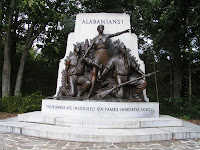 ve on November 19, 1863. But there is so much that we did not know and much more still to learn. Our intent is not to write a book, as many have already done so, but feel that it's important that if you, like us, only know the basics that we help fill in some of the blanks. Some historians feel that the battle at Gettysburg is the most important engagement in the history
ve on November 19, 1863. But there is so much that we did not know and much more still to learn. Our intent is not to write a book, as many have already done so, but feel that it's important that if you, like us, only know the basics that we help fill in some of the blanks. Some historians feel that the battle at Gettysburg is the most important engagement in the history of man.
of man. 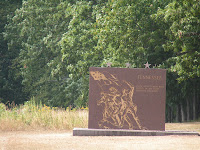
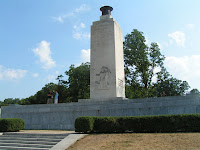
At the time of the battle the Southern armies led by General Lee were superior to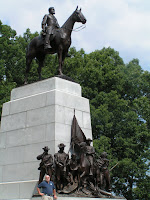 the Union army. War had been raging for over 26 months and the North's army and the northern population in general were demoralized. The sole intent of the Union army at this point in the war was to protect Washington, D.C. and Baltimore from the advancing Confederate army now located somewhere in Pennsylvania. As we went through our tour, it became apparent that decisions made and not made by the two armies turned the momentum of this three day battle numerous times each day. Lee's troops could have easily destroyed the Union forces if not for breaches in communication during the battle. If the Confederate army would have won the battle at Gettysburg, they most likely would have won the war. How would this nation look today if the south had prevailed instead of the north? Would it have remained one country? Two countries? And what about the many states west of the Mississippi River? Would they be part of this nation today? Or would we be dotted with additional countries throughout the land? If we were to look at it that way, a different outcome to this battle could quite possibly have dramatically changed the country that led the world through much of the 20th century.
the Union army. War had been raging for over 26 months and the North's army and the northern population in general were demoralized. The sole intent of the Union army at this point in the war was to protect Washington, D.C. and Baltimore from the advancing Confederate army now located somewhere in Pennsylvania. As we went through our tour, it became apparent that decisions made and not made by the two armies turned the momentum of this three day battle numerous times each day. Lee's troops could have easily destroyed the Union forces if not for breaches in communication during the battle. If the Confederate army would have won the battle at Gettysburg, they most likely would have won the war. How would this nation look today if the south had prevailed instead of the north? Would it have remained one country? Two countries? And what about the many states west of the Mississippi River? Would they be part of this nation today? Or would we be dotted with additional countries throughout the land? If we were to look at it that way, a different outcome to this battle could quite possibly have dramatically changed the country that led the world through much of the 20th century.
General Robert E. Lee led an army of 70,136 troops known as the Army of Northern Virginia. The newly promoted Union Major General George C. Meade led the Army of the Potomac and its 93,693 troops. The war had already seen the loss of over 300,000 lives in over 5,000 engagements since its start in 1861. When the war erupted in Charleston, SC, many citizens of the United States expected its troops to put a quick end to a minor "rebellion". Little did they realize the tenacity, dedication, and bravery of the Southern army. The first thing we learned was that the Confederate army entered Gettysburg from the north and west while the Union army entered from the south and east. Wonder how many people would have gotten the correct answer to that on Who Wants to Be a Millionaire! In the end the casualties for both sides were enormous making this battle one of the costliest in American history and the bloodiest in the Civil War. Approximately 10,000 men had died, 30,000 were wounded, and 11,000 were captured.
Gettysburg National Military Park is run by the National Park Service and consists of 5,989 acres of land. Located in the Park are 148 historic buildings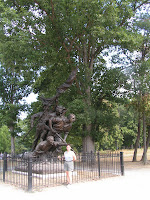 , 410 cannons, 1,320 monuments and memorials, and over 7,000 people are interred at the National Cemetery. The Park is dotted with colorful names that allow the history of the battle to come alive. Devil's Den, Little Round Top, Plum Run, and Spangler's Spring are only a few of the places where important engagements occured. The auto tour took about 4-1/2 hours to complete and consisted of 16 stops. As the day went on the temperature reached near 90 degrees, which was very similar to the temperatures during the three day battle. We were hot and tired and wondered how soldiers from both armies could endure the heat in full battle dress and smoke filling the air. Although we did finish the tour, we decided to return the next day and spend more time at Little Round Top, Devil's Den, and Cemetery Ridge, the sight of Pickett's Charge.
, 410 cannons, 1,320 monuments and memorials, and over 7,000 people are interred at the National Cemetery. The Park is dotted with colorful names that allow the history of the battle to come alive. Devil's Den, Little Round Top, Plum Run, and Spangler's Spring are only a few of the places where important engagements occured. The auto tour took about 4-1/2 hours to complete and consisted of 16 stops. As the day went on the temperature reached near 90 degrees, which was very similar to the temperatures during the three day battle. We were hot and tired and wondered how soldiers from both armies could endure the heat in full battle dress and smoke filling the air. Although we did finish the tour, we decided to return the next day and spend more time at Little Round Top, Devil's Den, and Cemetery Ridge, the sight of Pickett's Charge.

No comments:
Post a Comment